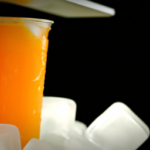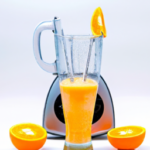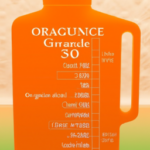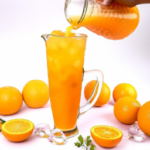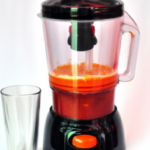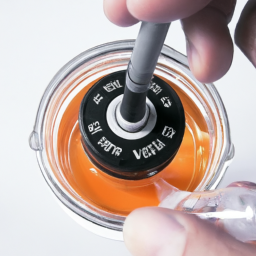Making orange juice from frozen concentrate is a quick and easy way to enjoy a refreshing citrus drink any time of the year. As someone who loves the taste of fresh oranges but doesn’t always have them on hand, I’ve found that frozen concentrate is a convenient alternative that doesn’t skimp on flavor.
In this article, I’ll walk you through the steps to make orange juice from frozen concentrate, from thawing the concentrate to straining the juice and adding sweeteners or flavorings if desired.
Whether you’re a busy parent looking for a healthy drink option for your kids or someone who wants to enjoy a taste of summer in the middle of winter, making orange juice from frozen concentrate is a great option to have in your arsenal.
Let’s get started!
Key Takeaways
- Using frozen concentrate is a quick and easy way to make orange juice with great flavor.
- Mixing the concentrate with cold water and adding alternative sweeteners can enhance the taste and make it healthier.
- Adding pulp or experimenting with different flavorings can give the juice a more authentic taste and unique twist.
- Chilling the juice before serving can help preserve its nutrients and make it more refreshing.
Gather Your Supplies and Ingredients
Before you start, make sure you’ve got everything you need. You’ll need a pitcher, water, and a can of frozen orange juice concentrate. You can use any brand of frozen orange juice concentrate, but I’d recommend getting a high-quality one for the best taste.
You’ll also need to decide how much juice you want to make. One can of frozen concentrate usually makes about 48 ounces of juice, so keep that in mind when selecting your pitcher.
When it comes to storing the ingredients, make sure to keep the frozen concentrate in the freezer until you’re ready to use it. It’s best to store the concentrate in an airtight container, so it doesn’t get freezer burn. As for the water, I like to use filtered water to ensure that the juice has the best possible taste.
Once you’ve gathered all your supplies and ingredients, it’s time to move on to the next step: thawing the frozen concentrate.
Thaw the Frozen Concentrate
Once you’ve got your hands on the concentrate, all you need to do is thaw it out. There are two ways to quick thaw the frozen concentrate:
-
Place the can in the fridge overnight. This is the easiest and most convenient method as it requires no monitoring or effort. However, it may take up to 24 hours for the concentrate to thaw completely.
-
Place the can in a bowl of warm water. This method requires more attention as you need to periodically change the water and make sure the can isn’t leaking. It’s also important to not leave the can in the water for too long as it can cause freezer burn and affect the taste of the juice.
Avoiding freezer burn is key in maintaining the quality of the orange juice. Freezer burn occurs when ice crystals form on the surface of the concentrate, causing it to dry out. To prevent this from happening, make sure the can is tightly sealed before placing it in the freezer. Additionally, try to use the concentrate within a few weeks of freezing it.
Now that the concentrate is thawed, it’s time to measure and mix it with water to make the juice.
Measure and Mix the Concentrate and Water
To mix the concentrate and water, you’ll need to measure out the appropriate amount of each ingredient according to the instructions on the can. Usually, the ratio is 1 can of concentrate to 3 cans of water. However, if you prefer a stronger or weaker taste, you can adjust the ratio accordingly.
Remember to use cold water when mixing the concentrate to ensure that the flavor and nutrients are preserved. If you don’t like the taste of plain water, you can also use alternative liquids such as sparkling water or coconut water for a unique twist.
Once you’ve mixed the concentrate and water, you’re ready to move on to the optional step of adding sweeteners or flavorings to customize your orange juice to your liking.
Optional: Add Sweeteners or Flavorings
You might think that adding sweeteners or flavorings to your freshly mixed orange drink could make it too sugary or overpowering, but don’t worry – it’s all about finding the right balance for your taste buds.
Experimenting with different sweeteners is a great way to add a twist to your orange juice. You can try using honey, agave, or maple syrup as healthier alternatives to white sugar. If you prefer a low-calorie option, stevia or monk fruit sweeteners are also great choices. Just remember to start with a small amount and gradually add more until you reach your desired taste.
Adding unique flavorings is another way to elevate your orange juice game. A dash of vanilla extract or a pinch of cinnamon can give your drink a warm and cozy feel. For a refreshing twist, try adding a splash of coconut water or a squeeze of lime juice.
The possibilities are endless, so feel free to get creative and have fun with it! Now that you’ve added your sweeteners and flavorings, it’s time to juice or blend the mixture to create a perfectly smooth and delicious orange drink.
Juice or Blend the Mixture
Now it’s time to blend or juice the mixture to get that smooth and velvety texture you crave. There are two methods you can use: blending or juicing. If you prefer a pulpy texture, blending is the way to go. Simply pour the concentrate mixture into a blender and add some ice cubes if you want a chilled drink. Blend until the mixture is smooth and the ice cubes are crushed.
On the other hand, if you prefer a pulp-free juice, juicing is the way to go. Pour the concentrate mixture into a juicer and follow the manufacturer’s instructions. The juicer will extract the juice from the mixture, leaving the pulp behind.
Whichever method you choose, you’ll end up with a delicious and refreshing glass of orange juice.
Now that your juice is ready, the next step is to strain it to remove any remaining pulp.
Strain the Juice
After blending or juicing your mixture, it’s time to strain your freshly squeezed OJ to get rid of any remaining pulp so you can enjoy a smooth and silky glass of sunshine.
There are different straining techniques you can use depending on how much pulp you like in your juice. If you prefer a pulp-free juice, you can use a fine-mesh strainer or cheesecloth to remove all the pulp. However, if you like a little bit of pulp in your juice, you can use a coarser strainer to leave some pulp in the juice.
The consistency of your juice will also depend on the straining technique you use. If you use a fine-mesh strainer, your juice will be thinner and smoother. On the other hand, if you use a coarser strainer, your juice will be thicker and have more texture.
Once you have strained your juice, you can pour it into a pitcher and chill it in the fridge for a refreshing and tasty drink.
Chill the Juice
One way to enhance the flavor and refreshment factor of your freshly squeezed OJ is to chill it for a few hours before serving. Chilling the juice has several benefits that can make your drinking experience more enjoyable.
Firstly, chilling the juice helps to preserve its nutrients and flavor. When orange juice is exposed to heat or light, it can quickly lose its nutritional value and taste. By chilling the juice, you can slow down the oxidation process and keep the juice fresh for longer.
Secondly, chilled orange juice is more refreshing and thirst-quenching than room temperature juice. The coolness of the juice can help to soothe your throat and provide a burst of energy on a hot day.
Lastly, chilled orange juice is a great way to cool down after a workout or a long day at work.
There are several alternative chilling methods that you can use to chill your orange juice. You can place the juice in the fridge for a few hours, or you can add ice cubes to the juice to cool it down quickly. Another option is to freeze the juice in ice cube trays and use the frozen cubes to chill your juice without diluting it.
Whatever method you choose, make sure to chill your orange juice before serving to enjoy its full flavor and benefits.
Now, let’s move on to the next section and learn how to serve and enjoy your freshly squeezed orange juice!
Serve and Enjoy!
To fully savor the deliciousness of your tangy, refreshing juice, you’ll want to serve it in a tall, frosty glass that will make you feel like you’re sipping on a piece of heaven. When it comes to presentation ideas, you can add a little twist to your orange juice by garnishing it with a slice of fresh orange. This will not only make your drink look more visually appealing but also add a hint of extra flavor to it. Another idea would be to rim the glass with some sugar or salt, depending on your preference, to give your drink a sweet or savory kick.
Now that you have your orange juice ready, it’s time to think about pairing suggestions. A classic breakfast pairing would be a plate of pancakes or waffles, topped with some butter and maple syrup. If you’re looking for something more substantial, you could pair your juice with an egg and bacon sandwich or a breakfast burrito. For a healthier option, you could serve it with a bowl of oatmeal or a fruit salad. The possibilities are endless, so feel free to experiment and find your perfect pairing. With your glass in hand and your meal ready, it’s time to sit back, relax, and enjoy your delicious orange juice.
When it comes to tips and tricks, there are a few things to keep in mind to make the most out of your orange juice.
Tips and Tricks
Get ready to elevate your orange juice game with these simple tips and tricks that’ll leave your taste buds singing with joy. Making orange juice from frozen concentrate is a convenient and cost-effective way to enjoy the refreshing taste of oranges all year round.
However, some common mistakes can ruin the flavor and texture of your juice. Here are some tips to avoid those mistakes and make the perfect orange juice every time:
-
Use cold water: When mixing the concentrate with water, use cold water instead of warm or hot water. This’ll help preserve the flavor and aroma of the juice and prevent it from becoming too sweet.
-
Add some pulp: If you prefer pulp in your orange juice, you can add it to the concentrate before mixing it with water. This’ll give your juice a more natural and authentic taste.
-
Experiment with alternative sweeteners: If you want to reduce your sugar intake or try something different, you can use alternative sweeteners like honey, agave nectar, or stevia. Just make sure to adjust the amount according to your taste preference.
By following these simple tips, you can make delicious orange juice from frozen concentrate that’ll impress your family and friends. Don’t be afraid to experiment with different flavors and textures to find your perfect blend.
Frequently Asked Questions
How long can you keep frozen orange juice concentrate in the freezer before it goes bad?
The shelf life of frozen orange juice concentrate is typically one year. Proper storage is key to avoiding freezer burn and spoilage. Keep it sealed tightly and at a constant temperature to ensure maximum freshness.
Is it safe to consume orange juice made from thawed concentrate that has been left out at room temperature for a few hours?
No, it is not safe to consume orange juice made from thawed concentrate that has been left out at room temperature for a few hours. Thawed concentrate can harbor microbial growth, leading to potential foodborne illness.
Can you use a blender instead of a juicer to make orange juice from concentrate?
When making orange juice from concentrate, a blender can be used instead of a juicer. To enhance the flavor, add freshly squeezed orange juice or a pinch of salt. Both methods produce delicious orange juice, but the texture differs slightly.
Is it necessary to strain the juice after juicing or blending the mixture?
To each their own, but personally, I don’t find straining necessary when making orange juice from concentrate. It’s all about pulp preferences. If you don’t mind a little texture, skip the straining step and enjoy the juice as is.
Can you use fresh orange juice instead of water to mix with the concentrate?
Using fresh orange juice instead of water with frozen concentrate has pros and cons. The taste is richer and more natural, but it can be overpowering. Experiment to find the right balance for your taste preferences.
Conclusion
Phew! Making orange juice from frozen concentrate is easier than I thought! I followed the steps and, in no time, I had a pitcher of refreshing, homemade orange juice.
It was the perfect balance of sweet and tangy, and the best part is that I could customize it to my liking.
As I sipped on my orange juice, I couldn’t help but think about how making something from scratch can be so rewarding. It’s like planting a seed and watching it grow into a beautiful flower.
It takes time and effort, but the end result is always worth it. So, the next time you’re craving a glass of orange juice, try making it from frozen concentrate. Trust me, your taste buds will thank you.
Ilana has been a vegan for over 10 years. She originally made the switch for health reasons, but soon found herself becoming more and more passionate about the ethical and environmental implications of a vegan lifestyle. Ilana is the author of The Graceful Kitchen, a blog all about veganism. She loves to cook up delicious and nutritious vegan meals, and share her recipes with others who are interested in leading a cruelty-free life. Ilana is also a strong advocate for using whole foods as the foundation of a healthy diet, and believes that going vegan is one of the best ways to achieve this.




